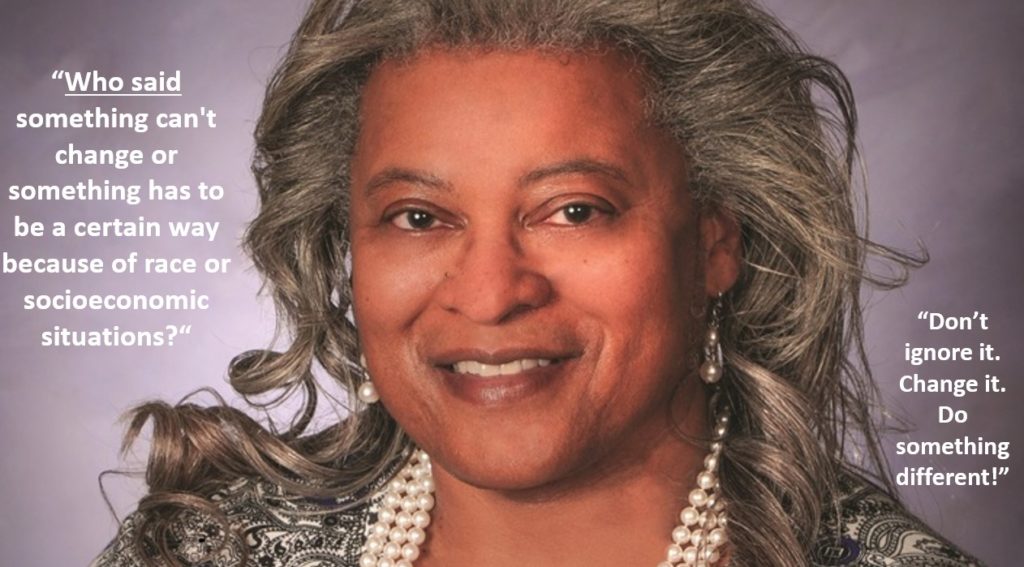This is Part I of a four-part series from my Changemaker Interview with community leader and activist Penny Franklin. Though she doesn’t really like to be called a “leader”, she has clearly led her community in some very important initiatives to address racial injustice. This first part of the series centers on quadrant 1 of the “Homegrown Solutions for a Patchwork World” framework. You will learn about Penny’s early life and motivations for change. Please watch, listen and read, and stay tuned for the remainder of the conversation to be published every few days over the next couple of weeks.
Penny was born and raised in Christiansburg in Montgomery County located in southwestern Virginia. She is “number four” among the seven children in her family. She grew up in a segregated community, but schools integrated when she entered the third grade. Her experiences as a young child in the first wave of integration had a big impact on her that she credits with developing her need to push hard on issues related to racial injustice.
As a young adult, her father went to Youngstown, Ohio as many African Americans did in the 40’s and 50’s to find work not available to them in the South. There he met and married Penny’s mother and brought her back to “Goose Holler” to live and raise a family. Penny remembers her mother saying that “God had this little piece of heaven ready for her.”
Raised in Ohio, her mother had not experienced the kind of segregation that dominated the South. She did not know, or care about, unwritten rules like “Black people aren’t allowed to try on clothes in a store.” She faced down discriminatory practices with a determined “Who said so?”
Penny credits her strong mother with engraining this perspective firmly into her belief system.
“Who said something can't change or something has to be a certain way because of race or socioeconomic situations or whatever?… Ignore it. Change it. Do something different.”
This attitude would serve her well in the difficult years to come. Penny’s early schooling was troublesome and ineffective. Before integration, the segregated school she attended for grades one and two was overcrowded and the teachers were “distracted” by concerns of what was to come. After integration, children were bussed to schools outside of their home neighborhoods and no one seemed happy about it. After two years of schooling with her neighbors and friends,
“All of a sudden we were separated and thrown into a world that was not good. I learned very little… I would make up stories of being sick, not feeling good, do things to try to make myself sick.”
She’d try to convince her astute mother that she didn’t feel well so she would not have to go to school where she was so unhappy. This sometimes resulted in her having to walk to school since she had intentionally missed the bus.
Penny avoided school for good reasons.
Her teacher treated her with open disdain and did not understand or care to address her needs as a student. Students had to literally fight to get by, and Virginia History made Penny partcularly uncomfortable.
I wasn't really sure why I didn't like it, but I just did not like it. I remember that book. I remember the smell of that book. The pictures in that book were basically black and white sketches, maybe a little tint of color to some of them.
With a teacher who made it clear she did not care for Penny and a curriculum that made no sense to her, the situation did not bring out Penny’s strengths and abilities. Despite “almost failing”, she managed to make up the work and pass from 4th grade onto fifth, but her “whole world” had changed. In the whole of her school career, Penny notes that only three of her white teachers really took the time to see her gifts and foster her learning and capacity for leadership.
There are two teachers who had a big influence on me and both their names are Mrs. Cox, Ms. Georgia Cox and Ms. Norma Cox. I remember Ms. Georgia Cox didn't really take anything from anybody and her class was labeled ‘that class” and we would get blamed for a lot of stuff…She would just ignore other teachers who would make comments…because…we were her class and…that's all there was to it.”
Penny remembers that after surviving those first terrible five years of school, she received the award for the highest grade point average in social studies. But this only happened after she reported to her mother the facts of her ongoing “tracked” education. In this setting,
“Students literally were not taught. We went to maybe one class, one regular class and then the rest of the day, you did nothing. We just sat in that classroom or they would find some odd jobs. It was very, very strange…So finally, they moved me to the next level of class and in that class, the young man who ended up being our class valedictorian was in that class, too…He and I battled for the highest grade point in that class back and forth…Before I was moved into that class, it was clearly… he was the top student when I came in and I'm coming in like six weeks or more behind because I was in this other class and was able to compete with him.”
Experiences like this validated Penny’s intelligence in spite of her seriously flawed education. She credits her sixth grade social studies teacher, Ms. Altizer, along with the two “Ms. Coxes” for seeing potential in her.
“They saw that I could learn and that I was interested and that I was making A's. They encouraged me and supported my thinking. That was when I understood, yeah, I've got a brain. There's some stuff going on here… Mrs. Cox, it was her standing up and just the way she carried herself as ‘I am somebody and I'm not taking a whole bunch of nothing off of anybody’. That helped me. I understood. This is what a woman could be. And she was very much like my mother with her attitude.”
Mrs. Georgia Cox’s similarities to her mother served as a model for Penny as she learned from another strong and determined woman. She also found a good outlet in athletics thanks to Mrs. Norma Cox who encouraged her development as a basketball player and shot putter. In the sports arena, she continued to develop her talents, her confidence and her capacity for leadership.
Penny sometimes wonders what might have happened if she had been given the chance at the education she deserved. But as a woman of strong faith, she knows that
“God has a plan. So sometimes those life experiences help us to understand and help others deal with things like that.”
Like her daughter, Penny’s mom faced discrimination in the integrated school system. After her father died suddenly when she was ten, her mother was hired under an effort in Montgomery County Public Schools to employ some African American teachers to help with a reading program. The white principal of the school never even looked at her when she reported to the school.
“So that environment was hostile to her even before the children got there.”
Coming from Ohio with a different mindset helped. Penny’s mother was civically involved with the NAACP and their church and she wasn’t prone to give up her autonomy or ability to speak out when something was wrong. One example Penny shares relates to how her mother helped to save and revamp an abandoned school building and make it into a gathering place for the African American community. The town tried to auction the building off, but when it was discovered that the church actually held the deed to the building, the auction was stopped at the last hour.
Penny was too young to be directly involved but she was watching; she was listening; and she was learning by example. Her mother’s drive to ask questions and to get things done to help her community influenced this self-proclaimed “introvert.” While Penny maintains her preference to avoid the limelight, it is clear that she has inherited her mother’s civic mindedness and her willingness to fight for what is right for her community.
“My mother will talk about her seven children. She says, ‘I have seven children and they're all different.’ She'll start naming the characteristics of this one is my…, and this one's… and I'm always the fighter. So … yeah, I'm okay with that.”
Stay tuned for Part 2 of my conversation with Penny Franklin to be published in the next few days. There she will share how she was spurred on by her mother’s example, her identity as a “fighter” and her strong faith to get involved in racial equity issues as they began to impact her children’s lives as they had her own.
Podcast: Play in new window | Download
Subscribe: Spotify | iHeartRadio | Email | TuneIn | Deezer | RSS | More


